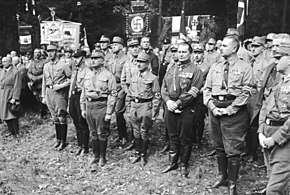Harzburg Front

The Harzburg Front was an alliance of anti-democratic nationalists and right-wing extremists against the second Brüning cabinet . The alliance between the NSDAP , DNVP , Stahlhelm, Bund der Frontsoldaten , Reichslandbund and the Pan-German Association only appeared at one meeting that took place on October 11, 1931 in Bad Harzburg . The venue was chosen because the NSDAP was involved in the government of the state of Braunschweig and interference from communists , who were particularly strong in the big cities, was not to be feared. After the first tensions had already become noticeable in Harzburg itself, the groups involved fought each other again a short time later and ran various candidates for the presidential election in March 1932 .
Attendees

On the initiative of Alfred Hugenberg , chairman of the German National People's Party since 1928, the “National Opposition” met on October 11, 1931 in Bad Harzburg for a major event to demonstrate their unity in the fight against the Weimar Republic . In addition to the NSDAP, the Stahlhelm, the Bund der Frontsoldaten and the Pan-German Association, with which the DNVP had already jointly initiated the failed referendum against the Young Plan two years earlier , the Reichslandbund , which represents the interests of farmers, and individual right-wing conservative personalities were also involved . They included August Wilhelm von Prussia , the son of the former emperor Wilhelm II , and the former Reichswehr general Hans von Seeckt . The participation of the former Reichsbank President Hjalmar Schacht caused a sensation . On the heavy industrial side, only Ernst Brandi came to Harzburg. Other heavy industrialists such as Paul Reusch and Fritz Springorum did not take part in the Harzburg meeting. The reason for this was, on the one hand, the dependence on state contracts, and Reich Chancellor Heinrich Brüning had also threatened to publish embarrassing details about the behavior of big industry and big banks during the banking crisis .
procedure
Surrounded by marches by their paramilitary groups, the leaders of the extreme right emphasized their common will to overthrow the presidential cabinet of Reich Chancellor Heinrich Brüning and demanded that his emergency ordinances be repealed and that the Reichstag be elected . However, it was only with great effort that the external impression of a united united front could be preserved. In a striking way, Adolf Hitler and Joseph Goebbels in particular demonstrated their distance from the other participants and little willingness to cooperate. Hitler did not take part in the joint lunch of the conference celebrities. After the National Socialist Sturmabteilung (SA) marched past , he demonstratively left the stands without waiting for the steel helmet to parade . In doing so, Hitler made clear his will not to subordinate himself to a broad right-wing front, and with provocative disdain pointed out his unconditional claim to leadership within the right camp. A week later, he demonstrated the independence of the National Socialist movement in Braunschweig at the largest parade of the National Socialists to date, with 100,000 participants .
Reactions
As a countermeasure to the Harzburg Front, parties and organizations loyal to the republic such as the Social Democratic Party of Germany , the General German Trade Union Federation and the Reichsbanner Schwarz-Rot-Gold founded the Iron Front on December 16, 1931 . Because of the votes of the SPD, the Harzburg Front's vote of no confidence in the Reichstag against Chancellor Brüning, which the DVP and the KPD had joined, failed on November 16 . A few weeks after the conference, the Society for the Study of Fascism was founded, in which representatives of the DNVP, NSDAP, the Stahlhelm and the Reichslandbund worked together.
Reminder on site
Since February 2009, the exhibition Harzburger Front - In lockstep with the dictatorship has been a critical reminder of the historical events of 1931 in the foyer of the Bad Harzburg health spa .
literature
- Karl Dietrich Bracher : The dissolution of the Weimar Republic. A study on the problem of the decline in power in a democracy. 5th edition. Düsseldorf 1971, pp. 360-367 and pp. 404-409.
- Heidrun Holzbach-Linsenmaier: Biedermann and arsonist . In: The time . No. 42, October 11, 1991.
- Larry Eugene Jones : The Harzburg Rally of October 1931. In: German Studies Review. 29, 2006, pp. 483-494.
- Searching for traces of the Harz region e. V .: Harzburg Front from 1931. Beacon for the destruction of a democratic republic. Historical event and remembering in the present. A documentation (= traces of Harz contemporary history. Issue 2). 2nd Edition. Paper plane, Clausthal-Zellerfeld 2009, ISBN 3-89720-904-7 .
- Search for traces of the Harz region eV: Harzburger Front. In lockstep with dictatorship. Exhibition catalog (= traces of Harz contemporary history. Special volume 1). Paper plane, Clausthal-Zellerfeld 2009, ISBN 978-3-89720-549-9 .
- Reinhard Sturm: Destruction of Democracy 1930–1933 . In: Weimar Republic (= information on political education . Issue 261). Revised new edition. Bonn 2011.
- Henry Ashby Turner : The Big Entrepreneurs and the Rise of Hitler. Siedler, Berlin 1985, ISBN 3-88680-143-8 , pp. 217ff.
Web links
- The main resolution of the Harzburg Conference (Harzburg Front) , October 11, 1931, in: 1000dokumente.de
- Searching for traces of the Harz region e. V. and documentation on the Harzburg Front in Bad Harzburg
- Exhibition Harzburger Front in Bad Harzburg
Individual evidence
- ↑ Heinrich August Winkler : German history from the end of the Old Reich to the fall of the Weimar Republic (= The long way to the west. Vol. 1). 4th edition. Beck, Munich 2000, ISBN 3-406-46001-1 , p. 500.
- ↑ Reinhard Neebe: Big Industry, State and NSDAP 1930-1933. Paul Silverberg and the Reichsverband der Deutschen Industrie in the crisis of the Weimar Republic. Vandenhoeck & Ruprecht, Göttingen 1981, ISBN 3-525-35703-6 , p. 107.